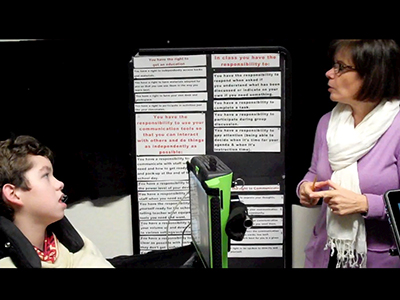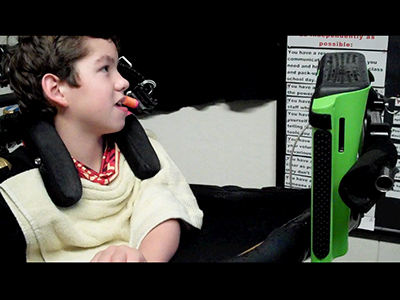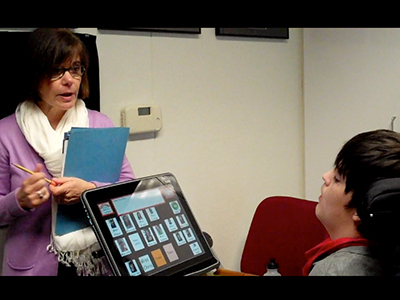Students engage in discussions and activities to develop awareness about the importance of being members of a community (classroom, school, city, etc.) and the rights and responsibilities they have as individuals within that community.
Purpose
Mentees learn about being a part of a community (e.g., the Self-Determination Program, their classroom, The Bridge School).
Mentees learn about rights and responsibilities and the difference between them.
Mentees and mentors discuss rights and responsibilities they have as members of a community.
Mentees identify rights and responsibilities that are important to them as an individual.
Mentees discuss with the team rights they may want to develop, protect and keep as an individual.
Mentees discuss with the team responsibilities they may want to take on and build competency with as an individual or as a student in a community.
Mentees begin to learn about goals and the concept of working towards something they want to change or achieve.
Mentees review all the information gathered from the Rights & Responsibilities activity and work with the Self-Determination Program team to determine if there is something within that information they would like to change or begin doing – For example:
- One right shared by student: Tell someone, “Can you turn on my talker?”
- One responsibility shared by student: “I would like to shut down my device, check the power level.”
Materials
- Individual cards that describe specific rights/responsibilities in the following 4 categories:
- You have the right to communicate
- You have the right to an education
- You have the responsibility to use your communication tools to interact with others
- You have the responsibility to complete your school work
- Rights & Responsibilities category titles (4)
- Large display/bulletin board divided into the 4 Rights & Responsibility categories
- Push-pins
Mentor Preparation
Mentors:
- review the Rights & Responsibilities assignment
- prepare an introduction and collaborate to determine who will do what portion of the introduction
- prepare personal examples to share
- Use the following sentence frames and prepare 3 examples for each:
- As a student, I think I have the right to .
- As a student, I think I have the responsibility to .
Activity
Self-Determination Program staff introduce the topic of Rights and Responsibilities and the difference between the two. Staff provide examples that students can use to draw connections to their own lives. For example:
“A right is a freedom that is protected, such as the right to free speech – saying what you feel, asking for what you need, etc. A responsibility is a duty or something you should do, such as recycling, doing your homework, packing your backpack to go home, setting up the lunch table if asked by the teacher, etc.” (Adapted from BrainPop Jr.)

The teacher and students discuss rights and responsibilities.

The students are asked to think about important rights in school.
The mentors provide examples of rights and responsibilities that they feel are important in their lives.
“This is a very important lesson for you. When I was your age, I did not know what my rights were as a student. For example, I didn’t understand that it was my right to ask for a drink during my lunch. Here are some of the rights that we feel are important.
- You have the right to use your talker and answer questions in class.
- You have the right to do your work in any way that you can. For example, using your talkers, your low-tech strategies or something else.
- You have the right to program what you want to say in your talker and ask for help if you need it.
- You have the right to speak up in class.
- You have the right to ask for help when needed.
- You have the right to read and write in class in a way that works best for you.
- You have the right to be treated the same as everyone else in class.
Here are some responsibilities that we feel are important.
- It is your responsibility to make sure your classwork and homework get done on time.
- It is your responsibility to get help when you don’t understand something or if something is too hard for you.
- It is your responsibility to listen in class.”
Self-Determination Program staff introduce and discuss different rights and responsibilities in four areas:
- the right to communicate
- the right to an education
- the responsibility to use communication tools to interact with others
- the responsibility as a student to complete school work

The student selects what he feels are important rights.

The student shares some of his important responsibilities.
Once all of the rights and responsibilities across the four areas are introduced and reviewed, mentors explain that mentees will vote on which rights and responsibilities are most important. Self-Determination Program staff introduce the concept of voting and develop a charter for the group. For example:
“Voting means you make a choice – we vote on who will be the President of the United States. Voting is both a right and a responsibility! We will put the rights and responsibilities on something called a charter. Our charter will be a document that describes the rights and responsibilities that we can all follow.”
Adaptations
- PPT slides to access content independently
Resource
“Rights and Responsibilities.” BrainPOP Jr. BrainPop International, 1999. Web. 02 Nov. 2013. https://jr.brainpop.com/socialstudies/citizenship/rightsandresponsibilities/

